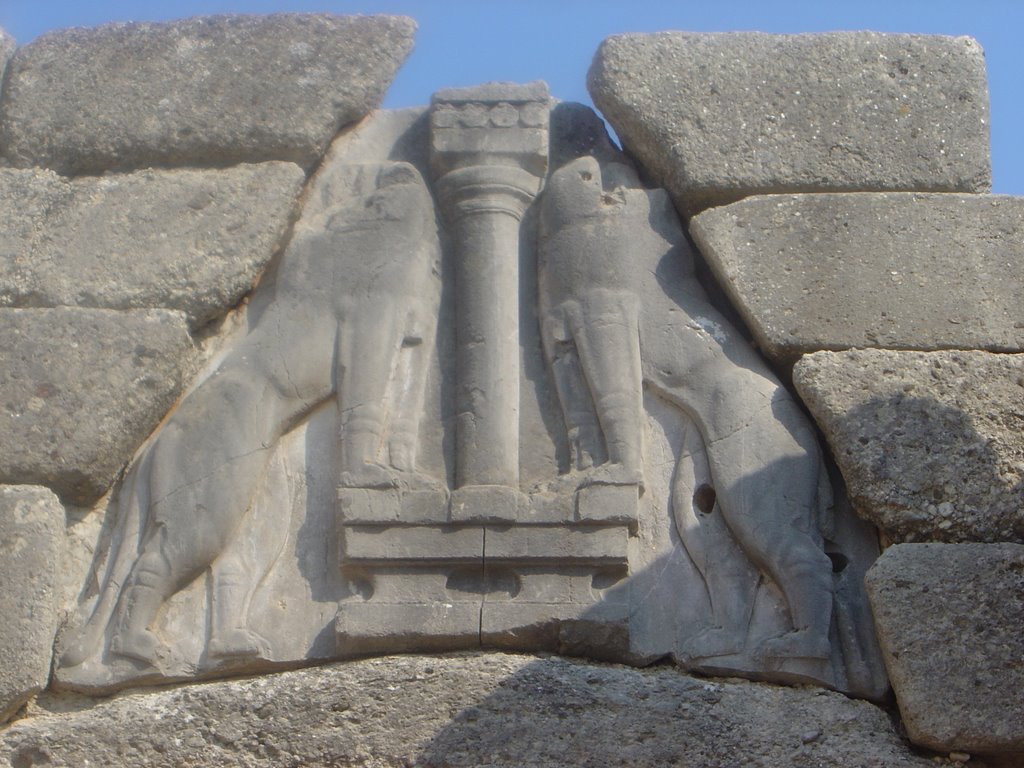We've been enjoying Greece a lot. Once you're out of the city you soon find that the landscape is very beautiful (if a little thirsty looking) and there is not much in the way of human presence. Building tends to be concentrated into small villages, of which there are many, but long tracts in between with plains and mountains (80% of Greece is mountainous).
The landscape is rocky, and instead of trees there is a tangle of bracken and weeds punctuated by occasional brilliant-purple "Judas trees". We don't whether it's due to pollution or not, but the horizon is always hazy. Makes the flow of mountains look very mysterious and ancient! We've followed the coast quite a bit, and the sea is a deep aquamarine - dotted with islands and fishfarms.
There are also many peculiar sights. There are countless half-finished buildings, mostly concrete construction with reinforcing bars sticking out the tops of columns, awaiting a second floor. Apparently people are allowed to build even when they don't have funds to complete, so all of these are works in progress - even if they take 10 years! (And many look like they've been sitting around.)
So... a quick summary of all the character-building stops we've made:
MEGARA - home of the tragedarian and poet Aeschylus [Note for Mum: pronounced esshyluss - rhymes with puss(ycat)], now a centre for heavy industry and the production of oil, gas and concrete. We passed the island of Salamis, site of the famous naval battle where the ancient Greeks routed the Persians.
CORINTH CANAL - dissects the shortest point on the peninsula, and is 6km long. Begun in the 7th century BC, but only completed in the 1880s. It's also 80m deep. Heady stuff. Apparently Nero also took a stab at it. He broke the first ground with a gold spade, then left 6,000 Jewsih slaves to work at it. Fortunately he was killed a few months later and work went on hold (again, and not for the first time).
SANCTUARY OF AESCLYPIUS and THEATRE OF EPIDAUROS - the sanctuary was built for the god of medicine, and people would come to be healed. During the night they would have visions indicating how they could be healed. Old people and pregnant women were not allowed to stay on the site in case they died, and instead camped outside. The nearby theatre has nearly perfect acoustics (look it up Jaimz), and is still used for annual performances of ancient plays. Maria Callas also performed there twice in the 1950s.
 MYCENEAN ACROPOLIS - legend has it that this was built by Perseus with the help of the race of giants, the Cyclopses. It is built with multi-tonne blocks placed on one another, without mortar (this style is known as 'cyclopean'). In reality, it was inhabited since neolithic times, and then subsequently by many other civilisations. Most famously, it was thought to house the burial ground of Agamemnon (from the battle of Troy), and a metric assload of gold was dug up there. It has an monolithic entranceway depicting two lions - the oldest European monumental statue. PS: our pictures of this site are totally sweet.
MYCENEAN ACROPOLIS - legend has it that this was built by Perseus with the help of the race of giants, the Cyclopses. It is built with multi-tonne blocks placed on one another, without mortar (this style is known as 'cyclopean'). In reality, it was inhabited since neolithic times, and then subsequently by many other civilisations. Most famously, it was thought to house the burial ground of Agamemnon (from the battle of Troy), and a metric assload of gold was dug up there. It has an monolithic entranceway depicting two lions - the oldest European monumental statue. PS: our pictures of this site are totally sweet.TOMB OF AGAMEMNON and TREASURY OF ARAEUS - turns out the tomb at the Mycenean Acropolis wasn't Agamemnon, but another Mycenean king. However, there is another burial ground in the area which is probably Agamemnon's real tomb - though it was empty when found.
ARCADIA - vast mountains covered in scrubby bush. Not what you'd expect from the name, but in myth it was home to Pan, god of nature.
No comments:
Post a Comment